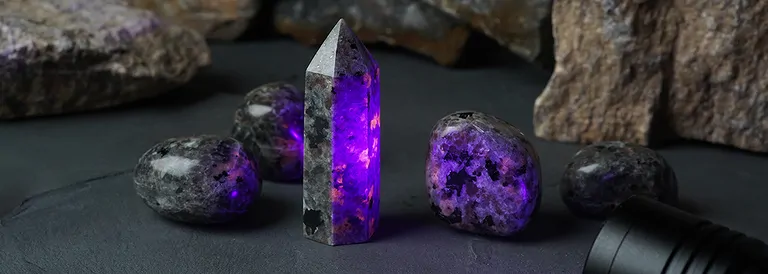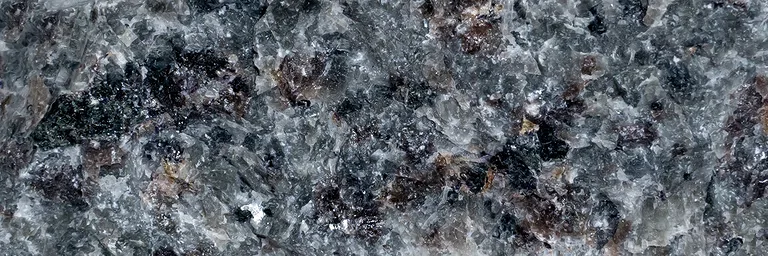
Stone of the month December 2025: Yooperlite
At the end of the year, peace and tranquillity return to nature and external life comes to a standstill. As the days get shorter and the temperatures drop, we feel the anticipation of the festive, reflective days. At the same time, however, there are obligations and tasks that often bring stress and a hectic pace. We usually use this time to focus on the essentials: Family, friendship and community.
At first glance, yooperlite appears unremarkable. It is a quartz-poor rock that was brought to the surface from the depths of the earth by volcanic activity. Yooperlite consists mainly of feldspar-rich syenite, which also contains sodalite that glows colorfully under UV light..

Yooperlite rough at daylight
Name Yooperlite and synonyms
The name Yooperlite (Yooperlith) refers to pebbles of syenite that contain fluorescent sodalite. They were first found in 2017 by Erik Rintamaki on the beaches of Lake Superior on the northern Michingan Peninsula. The people living there are called Yoopers, derived from U.P., the abbreviation of Upper Peninsula. Yooperlite is therefore made up of the name of the people living at the site in the USA (Yoopers) and the Greek word for stone (lithos).
Yooperlite is also known as glowing rock, occasionally also as glowdalite, derived from “glow” and “lithos” (stone). The term glowstone is also used for yooperlite.
Yooperlite as bracelet, stringed beads and more shapes at wholesale prices
Mineralogical profile of yooperlite
In mineralogical terms, yooperlite is syenite, i.e. a potassium feldspar-rich, quartz-poor, coarsely crystalline polymineral igneous rock. In addition to feldspar, other minerals also occur, e.g. pyroxene, amphibole and nepheline. Sodalite, which is also present, is responsible for the fluorescence.
Mineral class: silicates and germanates; feldspar group
Formation: magmatic
Color: light grey to dark grey with inclusions of dark grey sodalite; slightly colored areas indicate the presence of other minerals, e.g. amphibole and pyroxene
Luster: lustrous luster to greasy luster
Mohs hardness: 5 - 6

Occurrence, main supplier countries: Lake Superior (Michigan, USA), mainly on the north coast of the Upper Peninsula (Keweenaw Peninsula). Yooperlites probably originated in the Ontario region of Canada. The rounded shape indicates that the stones were transported to their current location by glaciers. Other sites of much lesser importance are in Brazil, Canada and Zambia.
Appearance: coarse-grained rock found as pebbles rounded by glaciers
Yooperlite at wholesale prices: bracelets, stringed beads and much more
Yooperlite - the stone that glows in the dark
Due to its complex mineralogical composition, it was long unclear why yooperlite glows under UV light or which component of the rock is responsible for this. Researchers at the University of Turku in Finland have now come a big step closer to solving the mystery. The decisive factor is the element titanium. If this and sulphur, potassium and iron are present in a certain concentration, the stones glow. The researchers hope that this finding will provide impetus for artificially produced luminous materials to be used, for example, in emergency exit signage.

Yooperlite pebbles under UV light
Use of Yooperlite
Yooperlite is cut into beads for bracelets and sttringed beads, into cabochons for pendants and other jewelry, and sold as pebbles, obelisks or in other forms for decorative purposes.
In its home country, the search for yooperlite is a popular pastime for locals and tourists alike. The aim is to find particularly bright or interestingly patterned yooperlites. Even though yooperlite is a rock and not a mineral, the pebbles are often presented in collections of UV minerals.
Application of yooperlite in gemstone healing
To date, there are no reliable findings on the effects of yooperlite. However, according to Michael Gienger's analytical gemstone healing, the mineralogical properties of yooperlite allow some conclusions to be drawn about its effects:
The feldspar content in Yooperlith helps us to take a new perspective, allowing us to see the familiar and the known in a new light. The mental horizon is broadened, new perspectives on life open up and mental flexibility is supported. Yooperlith provides the impetus to put old habits to the test. This allows new ideas to emerge that take (better) account of the current situation.
Magmatite helps you to learn quickly at the beginning of a new phase of life or project and to grow in the face of current challenges. This allows the inner potential to unfold optimally.
Bracelets, stringed beads and much more yooperlite at wholesale prices